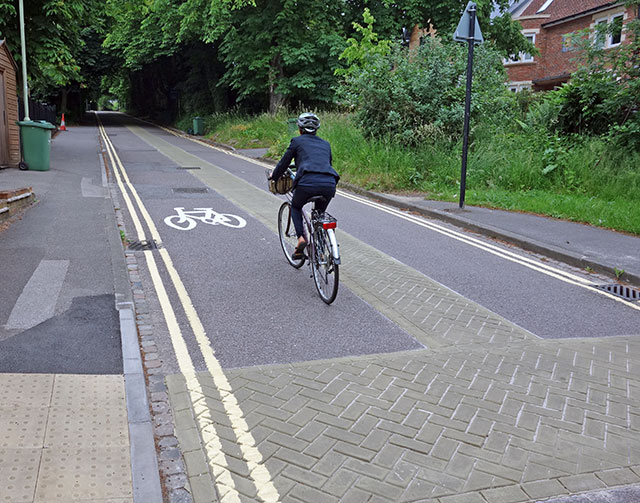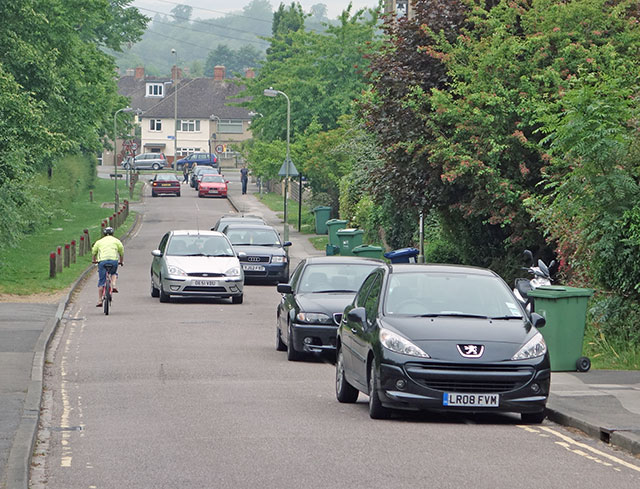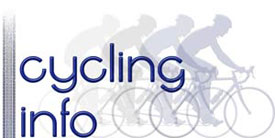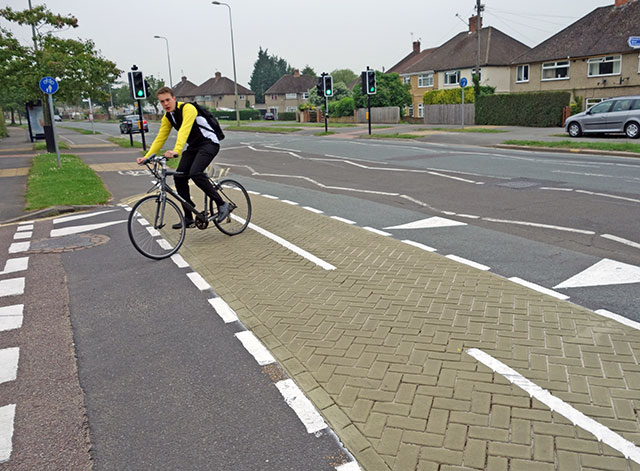Jack Straw lane is a narrow road, just big enough for two cars to squeeze past. It also provides a short cut from the city centre to the J.R. Radcliffe Hospital. Because traffic in Headington is often very congested, this minor road provides a convenient short cut, and is popular with taxis and other drivers. I’d heard that the Oxford city council had experimented with road markings to try and change drivers behaviour – providing road furniture which encourages slower speed, and discourages overtaking of cyclists.

The new road markings. I like it!
Richard Mann of cycling campaign group Cyclox said:
“We think the designs are excellent. Jack Straw’s Lane has a problem with being a bit of a rat run.
“We have always looked to the Netherlands and to Denmark. Sometimes the ideas work in our context and sometimes they don’t, but it is great that the county council is trying these things.” (Oxford mail)
I went to have a look and see whether it has made much difference.
The aim is that the more unusual road surfacing will make drivers more reluctant to overtake and keep to a slow speed. When I was there, quite a few were obeying the 20mph speed limit, but about 20% weren’t. I could tell they were speeding because there is one of those 20mph speed cameras (well not really a camera, just a sign comes on to say 20mph!) You probably won’t even spot it in photos, but it is there.
There was quite a high % of cyclists using the road. The hill is quite steep, so the cyclists fly down, but struggle up. Cars do overtake cyclists going up the hill, but then some cyclists are doing 5mph up the hill. To be honest, if you’re struggling up a hill, you don’t really want a car revving its engine, impatiently behind you. It’s best if they overtake with plenty of space.

The most testing moment was when two cars pass mid-way, there isn’t much room to breathe, and one taxi flying up the hill was a bit impatient. The 20mph warning sign flickered on, but it seemed little deterant.

Back down the hill, I saw some cyclists get boxed in by parked cars and cars coming down. That’s the problem with small sections of road calming measures, they are only partial to the road.
Overall, I think it’s worth a try. If I came across this road whilst driving, I think it would have the impact of reminding me this was a quiet back street and one to be taken slowly. As a cyclist, I wouldn’t expect much difference. But, if it makes a few drivers overtake more carefully, then it is worth it.
It also reminds me of:
Naked street experiment - removing road signs. Hans Monderman sought a radical approach to traffic management. He is famous for testing the validity of his schemes by walking backwards into moving traffic. His philosophy was the importance of putting the responsibility onto the road user, rather than trying to direct motorists. Hans said:
“We’re losing our capacity for socially responsible behaviour. The greater the number of prescriptions, the more people’s sense of personal responsibility dwindles.”
Cycle path and road markings at bottom of Jack Straw lane and Marston road.


As Tricycklist has stated, its pretty much the same where I live in Cornwall. After years of asking for some traffic calming method on our road because its straight and the 30mph limit is always ignored, the council installed a flashing 30mph sign, but it makes no difference.
A speed camera could not be installed because of the cost. Apparently the camera and installation would have been about £75,000, that was ok, but because of E.U. regs, to notify the different authorities, motoring groups, police, ambulance etc., that would cost a further £250,000.
People today have no patience, how many times we see on our Sunday a.m. club ride, cars cutting us up or speeding past us with surf boards on the roof rack because there pleasure is far more urgent than ours.
The only truly democratic, totally unavoidable, speed reducers are seriously steep sided humps the full width of the road. Or (even better) multiple asymmetric mushroom humps at frequent but irregular intervals. These actually work well.
Even when the sociopaths accelerate as hard as possible between these “irritating obstructions” their overall speed is much reduced.
“Decorating” the road surface with paint, signs, mild or pretend humps, noisy concrete cobbles, posts, boards, road narrowing measures and chicanes, etc. do absolutely nothing to reduce traffic speeds in the real world. I see all of these pretend measures to illegal driving behaviour on my daily rides, and drives, in Denmark. They do not work. At all.
Regulars and locals will always practice pushing their maximum speed over any new traffic calming “impediments” to their illegal progress. Once past the know obstacle their behaviour returns immediately to the illegal and insane. Shopping streets, schools, nurseries and hospitals mean nothing to the vast majority of drivers. Their own need to break the law by speeding is far greater than the public’s right to survival.
Every village and town in Denmark is “protected” by large speed indicator boards and flashing orange lights. These boards are totally ignored by well over 90% of all drivers. They do not work. At all.
Only serious discomfort and a very high risk of damage to their own vehicle will ever reduce driving speeds. Only vicious humps and mushrooms work on the vast majority of driving sociopaths. They work. Every time.
When 90% of drivers in Denmark speed illegally, 90% of the time, then present traffic calming measures are a completely transparent fraud. Or a very old and very tired joke which everyone gets.
So don’t bother sending any imitating “road design engineers” over on a jolly spree, at taxpayer’s expense, to examine how the imitation, Danish road calming measures work. They don’t work. At all. Period.
Nor will they work anywhere else.